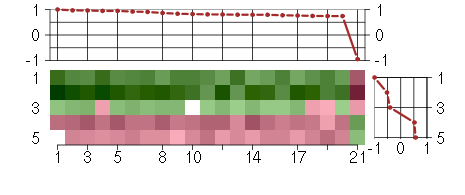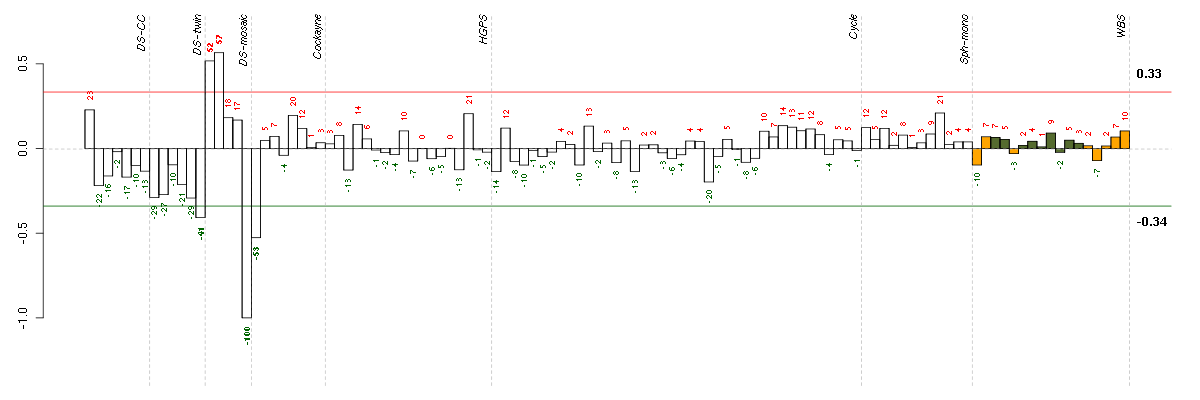



Under-expression is coded with green,
over-expression with red color.

immune system process
Any process involved in the development or functioning of the immune system, an organismal system for calibrated responses to potential internal or invasive threats.
antigen processing and presentation of peptide antigen via MHC class I
The process by which an antigen-presenting cell expresses a peptide antigen on its cell surface in association with an MHC class I protein complex. Class I here refers to classical class I molecules.
antigen processing and presentation of endogenous peptide antigen
The process by which an antigen-presenting cell expresses a peptide antigen of endogenous origin on its cell surface in association with an MHC protein complex. The peptide is typically a fragment of a larger endogenous protein which has been degraded within the cell.
defense response
Reactions, triggered in response to the presence of a foreign body or the occurrence of an injury, which result in restriction of damage to the organism attacked or prevention/recovery from the infection caused by the attack.
response to stress
A change in state or activity of a cell or an organism (in terms of movement, secretion, enzyme production, gene expression, etc.) as a result of a disturbance in organismal or cellular homeostasis, usually, but not necessarily, exogenous (e.g. temperature, humidity, ionizing radiation).
immune response
Any immune system process that functions in the calibrated response of an organism to a potential internal or invasive threat.
biological_process
Any process specifically pertinent to the functioning of integrated living units: cells, tissues, organs, and organisms. A process is a collection of molecular events with a defined beginning and end.
antigen processing and presentation
The process by which an antigen-presenting cell expresses antigen (peptide or lipid) on its cell surface in association with an MHC protein complex.
antigen processing and presentation of endogenous antigen
The process by which an antigen-presenting cell expresses antigen (peptide or lipid) of endogenous origin on its cell surface in association with an MHC protein complex.
antigen processing and presentation of endogenous peptide antigen via MHC class I
The process by which an antigen-presenting cell expresses a peptide antigen of endogenous origin on its cell surface in association with an MHC class I protein complex. The peptide antigen is typically, but not always, processed from a whole protein. Class I here refers to classical class I molecules.
innate immune response
Innate immune responses are defense responses mediated by germline encoded components that directly recognize components of potential pathogens.
antigen processing and presentation of peptide antigen
The process by which an antigen-presenting cell expresses peptide antigen in association with an MHC protein complex on its cell surface, including proteolysis and transport steps for the peptide antigen both prior to and following assembly with the MHC protein complex. The peptide antigen is typically, but not always, processed from an endogenous or exogenous protein.
response to stimulus
A change in state or activity of a cell or an organism (in terms of movement, secretion, enzyme production, gene expression, etc.) as a result of a stimulus.
all
This term is the most general term possible
immune response
Any immune system process that functions in the calibrated response of an organism to a potential internal or invasive threat.
antigen processing and presentation of endogenous peptide antigen
The process by which an antigen-presenting cell expresses a peptide antigen of endogenous origin on its cell surface in association with an MHC protein complex. The peptide is typically a fragment of a larger endogenous protein which has been degraded within the cell.
innate immune response
Innate immune responses are defense responses mediated by germline encoded components that directly recognize components of potential pathogens.
antigen processing and presentation of endogenous peptide antigen via MHC class I
The process by which an antigen-presenting cell expresses a peptide antigen of endogenous origin on its cell surface in association with an MHC class I protein complex. The peptide antigen is typically, but not always, processed from a whole protein. Class I here refers to classical class I molecules.

extracellular region
The space external to the outermost structure of a cell. For cells without external protective or external encapsulating structures this refers to space outside of the plasma membrane. This term covers the host cell environment outside an intracellular parasite.
cellular_component
The part of a cell or its extracellular environment in which a gene product is located. A gene product may be located in one or more parts of a cell and its location may be as specific as a particular macromolecular complex, that is, a stable, persistent association of macromolecules that function together.
all
This term is the most general term possible

APOL1apolipoprotein L, 1 (209546_s_at), score: 0.74 BCAMbasal cell adhesion molecule (Lutheran blood group) (40093_at), score: 0.79 CA11carbonic anhydrase XI (209726_at), score: 0.9 CFIcomplement factor I (203854_at), score: 0.74 ELOVL2elongation of very long chain fatty acids (FEN1/Elo2, SUR4/Elo3, yeast)-like 2 (213712_at), score: 0.82 ERAP1endoplasmic reticulum aminopeptidase 1 (214012_at), score: 0.83 FOSv-fos FBJ murine osteosarcoma viral oncogene homolog (209189_at), score: 0.94 GPC4glypican 4 (204983_s_at), score: 0.81 HHEXhematopoietically expressed homeobox (215933_s_at), score: 0.97 IL23Ainterleukin 23, alpha subunit p19 (211796_s_at), score: 0.79 NINJ1ninjurin 1 (203045_at), score: 0.76 PDE1Cphosphodiesterase 1C, calmodulin-dependent 70kDa (207303_at), score: -0.95 PDLIM3PDZ and LIM domain 3 (209621_s_at), score: 0.86 PKP2plakophilin 2 (207717_s_at), score: 0.96 PTGDSprostaglandin D2 synthase 21kDa (brain) (212187_x_at), score: 0.92 RARRES3retinoic acid receptor responder (tazarotene induced) 3 (204070_at), score: 0.8 SCARB1scavenger receptor class B, member 1 (201819_at), score: 0.94 SCG2secretogranin II (chromogranin C) (204035_at), score: 1 TAPBPLTAP binding protein-like (218746_at), score: 0.77 TM6SF1transmembrane 6 superfamily member 1 (219892_at), score: 0.8 ZNF711zinc finger protein 711 (207781_s_at), score: 0.75
| Id | sample | Experiment | ExpName | Array | Syndrome | Cell.line |
|---|---|---|---|---|---|---|
| 47C.CEL | 5 | 3 | DS-mosaic | hgu133plus2 | Down mosaic | DS-mosaic 5 |
| E-GEOD-3407-raw-cel-1437949557.cel | 1 | 4 | Cockayne | hgu133a | CS | eGFP |
| 6Twin.CEL | 6 | 2 | DS-twin | hgu133plus2 | none | DS-twin 6 |
| 46A.CEL | 1 | 3 | DS-mosaic | hgu133plus2 | none | DS-mosaic 1 |
| 46B.CEL | 2 | 3 | DS-mosaic | hgu133plus2 | none | DS-mosaic 2 |
